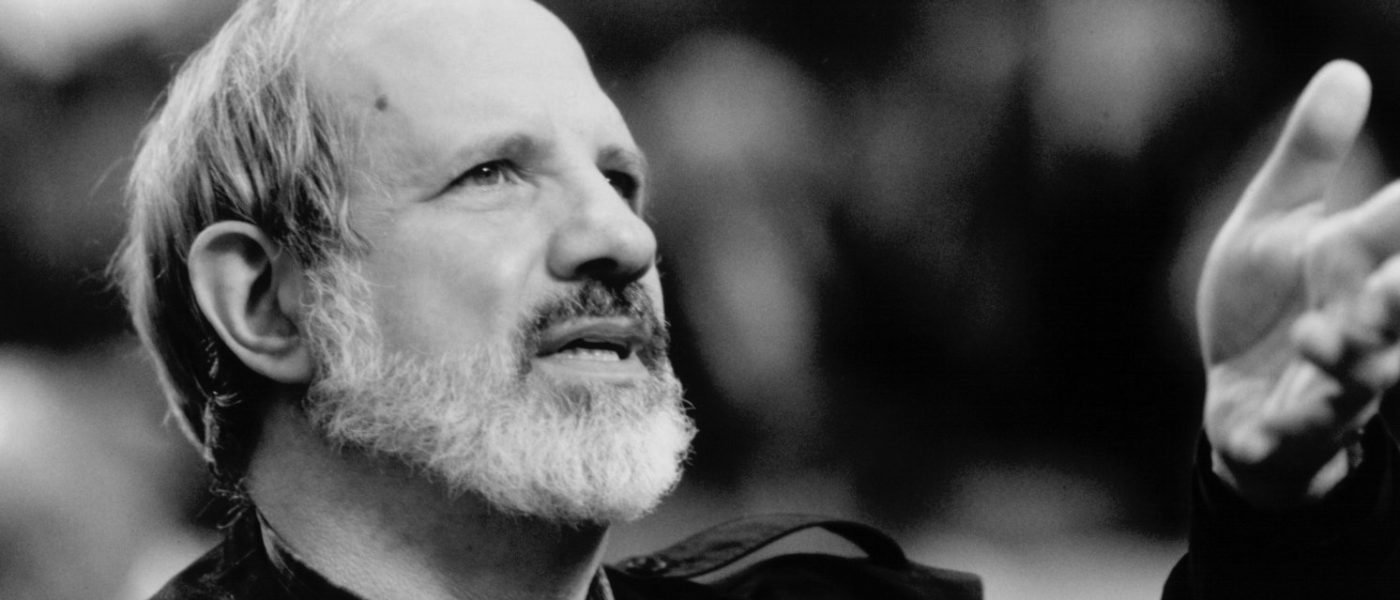The Visual Storyteller Finds Truth in the Lies… at 24 Frames per Second.
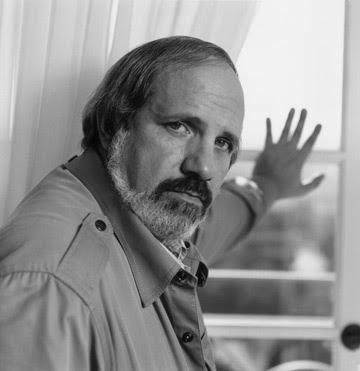 Controversial from his moment of relevance, filmmaker Brian De Palma’s infamy is well-earned yet overshadowing. That he’s spent his career unapologetically trading in violence, perversity and voyeurism has led to repeated allegations of misogyny and gratuitousness in his work. Currently at age 75, the skilled visual stylist has become accustomed to essentially shrugging it all off. This is a grown-up show of postmodern wet-willies, social shocks, and political bleakness. Nothing for kids in his entire oeuvre. An oeuvre, by the way, that has recently been the subject of the theatrically released documentary De Palma, by Noah Baumbach and Jake Paltrow. The three are said to have dinner together every week.
Controversial from his moment of relevance, filmmaker Brian De Palma’s infamy is well-earned yet overshadowing. That he’s spent his career unapologetically trading in violence, perversity and voyeurism has led to repeated allegations of misogyny and gratuitousness in his work. Currently at age 75, the skilled visual stylist has become accustomed to essentially shrugging it all off. This is a grown-up show of postmodern wet-willies, social shocks, and political bleakness. Nothing for kids in his entire oeuvre. An oeuvre, by the way, that has recently been the subject of the theatrically released documentary De Palma, by Noah Baumbach and Jake Paltrow. The three are said to have dinner together every week.
De Palma’s is an absurd cinema of the unreal, the nearly real, seriously informed by the real. Often baroque, often melodramatic, sometimes overly dramatic, even operatic. It’s true that not every film works, but when they do (and more than enough of them do), De Palma is again vindicated in his reputation as one of the “film school generation’s” most uncompromising masters. A certain showmanship of discomfort, at times a Grand Guignol, is key in the stories he chooses to tell and re-tell. And we, the audience, have to work for our intellectual rewards, whatever they may be. All this, even as he sings the same song in different ways. (But almost always with some split-screen, overhead shots, canted angles, and a Pino Donaggio score.)
Following a successful spate of overt homages to the films Psycho, Vertigo and Rear Window, among others, De Palma was all too often and all too easily dismissed as “the American Hitchcock”. Before that, due to his experimental cinema-savviness and freewheeling early comedies, he was branded “the American Godard”. Jean-Luc Godard famously said that cinema is “truth at 24 frames per second”. If De Palma is to be his stateside version, it’s only fitting that he be contrarian (and the same could be said of Hitchcock as well), humorously retorting that the camera lies all the time, that cinema is lies at 24 frames per second. (An old quote of his which he reused – homaging himself? – in an interview with The Guardian in early June 2016.)
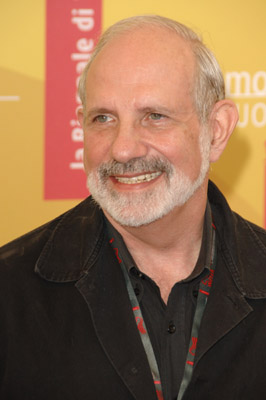
De Palma wields a cinematic self-awaredness, even an autobiographical element, that rarely shows without previous knowledge. (Highly recommended reading: Julie Salamon’s The Devil’s Candy, chronically the making of De Palma’s epic misfire The Bonfire of the Vanities.) Growing up a student of science, and made to learn of infidelity the hard way, De Palma was building computers and engaging in obsessive surveillance of a tragically philandering parent when he was still a student – not at all unlike Keith Gordon’s science-whiz-on-a-mission in 1980’s Dressed to Kill.
His perhaps greatest film, 1982’s Blow Out, pits a frantic John Travolta against a savage John Lithgow, who stalks a blindly patriotic Philadelphia as “The Liberty Bell Killer”. Made in the shadow of Chappaquiddick as an informed riff on Antonioni’s Blow-Up, Blow Out breeds an inescapable air of hopelessness. This film is just one example. De Palma has been telling us for years that America is broken. In this current nightmare time of hairpin racial strife, systemic corruption and election year demagoguery, maybe it’s time we start listening.
Obsession
(1976, Columbia Pictures, dir. Brian De Palma)
by Justin Mory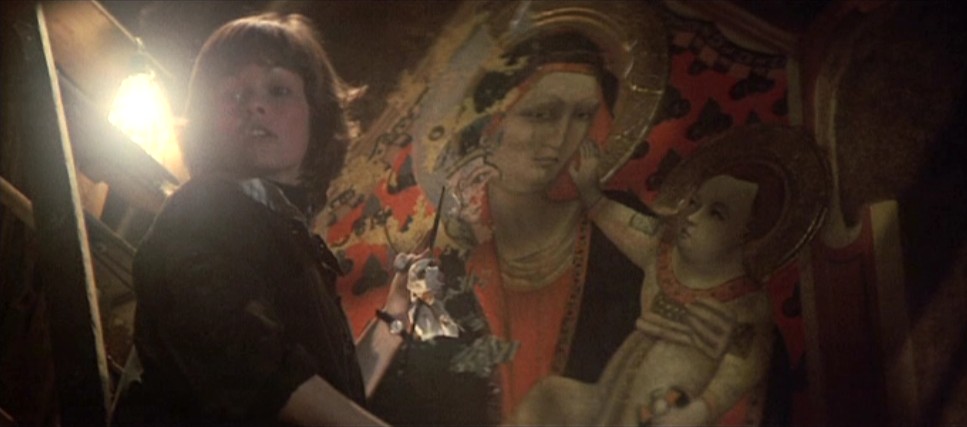
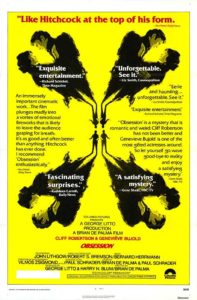 Among unseen Brian De Palma movies I was quite eager, while also a bit apprehensive, to view his 1976 thriller Obsession. Released the same year as his classic Stephen King adaptation Carrie, De Palma’s Hitchcockian follow-up to an earlier thriller, 1973’s horror/mystery Sisters, comes halfway through a decade that also included the Vietnam-era satire Hi, Mom! (1970), continued through the surrealistic shock-rock musical Phantom of the Paradise (1974), and that would conclude with the big budget horror/adventure film The Fury (1978). In short, the ’70s saw this varied filmmaker firing on all cylinders, cinematically-speaking, essaying a wide variety of genres while building an “auteurist” approach to his filmmaking craft.
Among unseen Brian De Palma movies I was quite eager, while also a bit apprehensive, to view his 1976 thriller Obsession. Released the same year as his classic Stephen King adaptation Carrie, De Palma’s Hitchcockian follow-up to an earlier thriller, 1973’s horror/mystery Sisters, comes halfway through a decade that also included the Vietnam-era satire Hi, Mom! (1970), continued through the surrealistic shock-rock musical Phantom of the Paradise (1974), and that would conclude with the big budget horror/adventure film The Fury (1978). In short, the ’70s saw this varied filmmaker firing on all cylinders, cinematically-speaking, essaying a wide variety of genres while building an “auteurist” approach to his filmmaking craft.
Which is partly why the director’s own “obsession” with the works of Alfred Hitchcock became (and remains) somewhat troubling for some reviewers. Like Sisters, whose ultimate though oblique source was Hitchcock’s Psycho (1960), De Palma’s Obsession features a score by Hitchcock’s longtime composer Bernard Herrmann, one of his last before passing away in 1975, and further evokes the Master of Suspense in terms of stylistic and storytelling technique. But here, with Obsession, Paul Schrader’s script and De Palma’s direction are unabashedly “fixated” on another Hitchcock film, the dream-like mystery/thriller Vertigo (1958), to the point where Obsession virtually “becomes”Vertigo.
Opening in 1959 New Orleans, wealthy land developer Michael Courtland (Cliff Robertson) deals ineffectually with a kidnapping plot involving his beloved wife Elizabeth (Genevieve Bujold) and daughter Amy, resulting in his loss of both. 15 years later, Courtland, still haunted by the past, travels in Florence, Italy to a crumbling cathedral where he first met his deceased wife and here encounters her exact double (also Genevieve Bujold) working on its reconstruction… Without resorting to the dreaded S-word, I might add before getting too far into the plot that the thematic elements of loss, guilt, and, yes, obsession are very much apparent in De Palma’s reiteration of Vertigo‘s basic premise of a “woman returning from the dead”, but the frank screen portrayal of Obsession‘s male protagonist’s dreams and desires inject something disconcertingly extra to the romantic and overwrought tone of the original.
So, again, the Vertigo-ish aspects of Obsession are all but inescapable for those familiar with the earlier masterpiece, but like his later, overtly Psycho-influenced thriller Dressed to Kill (1980), De Palma adds problematic layers undreamt of by The Master. Indeed, the swirling camera around Courtland and his “re-found” lost love in a deliriously-lit airport lobby may be an almost exact copy of the most famous shot from Vertigo; however, the further provocative elements offered by De Palma’s Obsession make the act of “viewing” the scene even more disturbing than Hitchcock himself intended.
Casualties of War
(1989, Columbia Pictures, dir. Brian De Palma)
by Robert Hornak
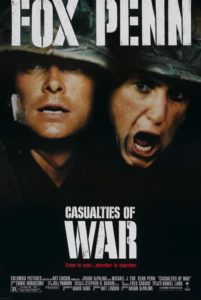 Sean Penn quickly establishes himself as the king of the Vietnamese jungle, at least in terms of his capacity to turn on the heat too high too early. His proto-James Dean pain face, complete with glazed shock-eyes and stricken-confused mouth agape, is so broad – framed further by a Your Show of Shows-style New York accent – in such an otherwise clearly composed movie that it must be deliberate. But I can’t imagine why. The setting is all we really need to know that men can be crazy, so the shtick is redundant, and we certainly can’t take his broadness to be a necessary foil to our golden hero, Eriksson, played by Michael J. Fox, whose TV-pal/McFly-earnest baggage is so heavy with goodness (it outweighs his rucksack by at least twice) that every foul word from his mouth elicits a reprimanding “Language!” from the living room couch. The contrast between the two has the effect of infusing everything with a certain cartoony two-dimensionality.
Sean Penn quickly establishes himself as the king of the Vietnamese jungle, at least in terms of his capacity to turn on the heat too high too early. His proto-James Dean pain face, complete with glazed shock-eyes and stricken-confused mouth agape, is so broad – framed further by a Your Show of Shows-style New York accent – in such an otherwise clearly composed movie that it must be deliberate. But I can’t imagine why. The setting is all we really need to know that men can be crazy, so the shtick is redundant, and we certainly can’t take his broadness to be a necessary foil to our golden hero, Eriksson, played by Michael J. Fox, whose TV-pal/McFly-earnest baggage is so heavy with goodness (it outweighs his rucksack by at least twice) that every foul word from his mouth elicits a reprimanding “Language!” from the living room couch. The contrast between the two has the effect of infusing everything with a certain cartoony two-dimensionality.
But it works, insofar as this true story is beaten out into a morality tale about America – who it wants to be, coming face to face with who it might really be. There are moments De Palma wants to stress this and he goes over the top: when Erikkson wants to smuggle the raped local girl back to her village but realizes he’d be a deserter for leaving his group, the moment is over-emotionalized with Ennio Morricone’s near-operatic score over canted angles and weeping. Later, Erikkson gets a slow-dolly-around and a speech right out of a Fuller movie about how they’re doing it all wrong in Vietnam, complete with a mournful military funeral trumpet, but wispy Fox doesn’t have the heft to pull it off so it’s accidentally funny. These moral-of-the-story moments are hard to watch, but they play better in memory, when the hype of expectation is gone, and you’re left to think through the point of it all.
And I’m not sure I get that point…As Eriksson goes up the chain, meeting only higher ranking officers with no sanctuary for him despite the villainy he’s witnessed, we think we’re headed toward another take on absurdly rigid rule-keeping in a boys will be boys world, a la Paths of Glory. But the movie careens back toward correct justice for the rapists – a validation of Eriksson’s “mobile morality” as Fox himself put it (meaning, what’s wrong is wrong everywhere), but it shoots a hole in the ethical tension that makes this hard movie end on a soft note. Where else can it go from there but to a sunlit shot of vindicated Erikkson ladled with Morricone?
The best thing about this first viewing is Ving Rhames, though he’s only in it for ten minutes. He’s got a kind of shouting resignation to the limits of his power that’s funny coming from a man so physically strong. I’m enamored enough of the way he lets the line, “Be advised, you best just relax and try to forget about this thing,” roll off with a nod toward his own hollowed-out authority, I watched the moment five times. In fact, I’d watch a whole movie about that guy.
Mission: Impossible
(1996, Paramount Pictures, dir. Brian De Palma)
by Sharon Autenrieth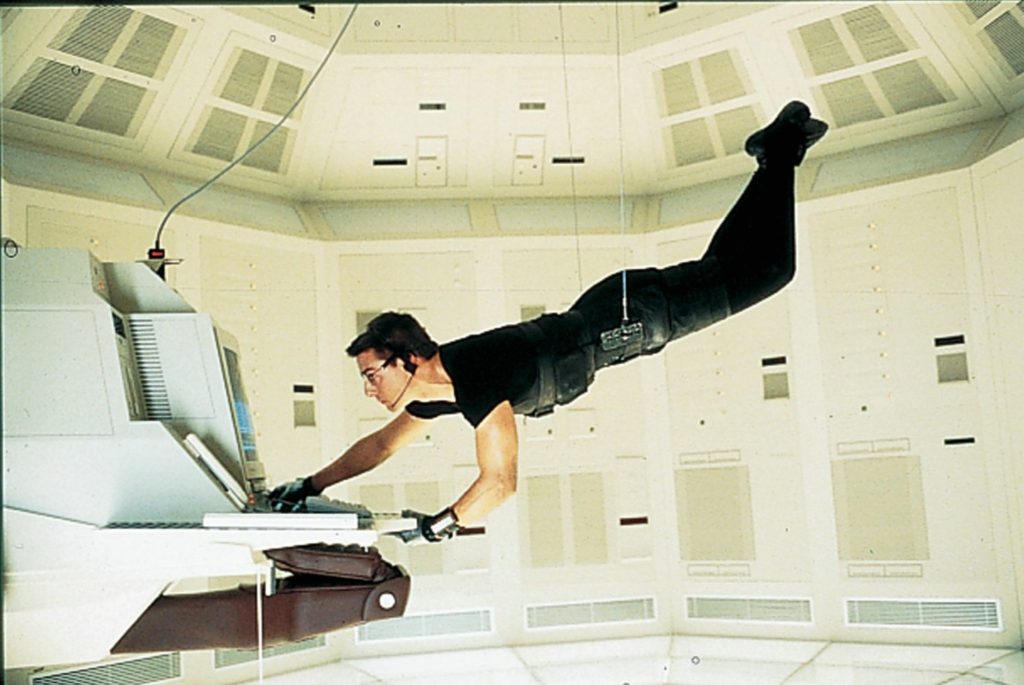
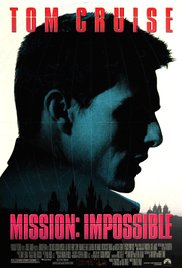 I need someone who appreciates Brian De Palma’s style to walk me through a shot by shot study of Mission: Impossible so that I can get it. I tried, I really did, and my inability to enjoy this movie leaves me a little embarrassed – as if I’m too tone deaf to appreciate a good peace of music. Because I hear, from people that I trust and respect, that this is a great action movie. To me, this TV show adaptation seems like a disconnected series of action sequences interrupted by one dimensional characters talking about things that little interest me. So that’s my initial take, but I’m going to try to accentuate the positive. Firstly, Tom Cruise is a great action lead, something he’s demonstrated many times since Mission: Impossible. It’s not simply that he can convincingly pull off the action, but that he is very good at depicting the tension that must surely come with nearly dying several times in less than two hours. His eyes become glassy, the veins in his forehead tighten, he looks like he’s about to have an aneurysm. I always like watching Cruise go through this transformation, and in the case of Mission: Impossible, this immediately precedes one of the nifty action sequences in which Cruise’s character (agent Ethan Hunt) escapes from a restaurant in a tidal wave of his own making.
I need someone who appreciates Brian De Palma’s style to walk me through a shot by shot study of Mission: Impossible so that I can get it. I tried, I really did, and my inability to enjoy this movie leaves me a little embarrassed – as if I’m too tone deaf to appreciate a good peace of music. Because I hear, from people that I trust and respect, that this is a great action movie. To me, this TV show adaptation seems like a disconnected series of action sequences interrupted by one dimensional characters talking about things that little interest me. So that’s my initial take, but I’m going to try to accentuate the positive. Firstly, Tom Cruise is a great action lead, something he’s demonstrated many times since Mission: Impossible. It’s not simply that he can convincingly pull off the action, but that he is very good at depicting the tension that must surely come with nearly dying several times in less than two hours. His eyes become glassy, the veins in his forehead tighten, he looks like he’s about to have an aneurysm. I always like watching Cruise go through this transformation, and in the case of Mission: Impossible, this immediately precedes one of the nifty action sequences in which Cruise’s character (agent Ethan Hunt) escapes from a restaurant in a tidal wave of his own making.
So that’s actually two positives: Cruise gives a taut, persuasive performance, and there are nifty action scenes. The one involving both a train and a helicopter is certainly something to behold, and reminded me of the crop duster scene in North By Northwest. Here’s another positive: it was a bold move to kill off most of the big name cast in the first few minutes of the movie. Once I got over being sad that I wasn’t going to get a bigger dose of Kristin Scott Thomas, I had to give credit to De Palma for surprising me with that plot twist.
Why wasn’t this enough? Why wasn’t I content with a solid lead and well executed action scenes in what was, after all, an action movie? As I said earlier, those scenes seemed loosely tied together rather than part of one compelling central narrative. And the characters – those that survived past Act One – seemed flat and uninteresting. But your mileage may vary: Mission: Impossible has a fine reputation about many other film fans. Maybe, this time, the problem isn’t really with the movie. Maybe it’s me.
Phantom of the Paradise
(1974, Harbor Productions, dir. Brian De Palma)
by Max Foizey
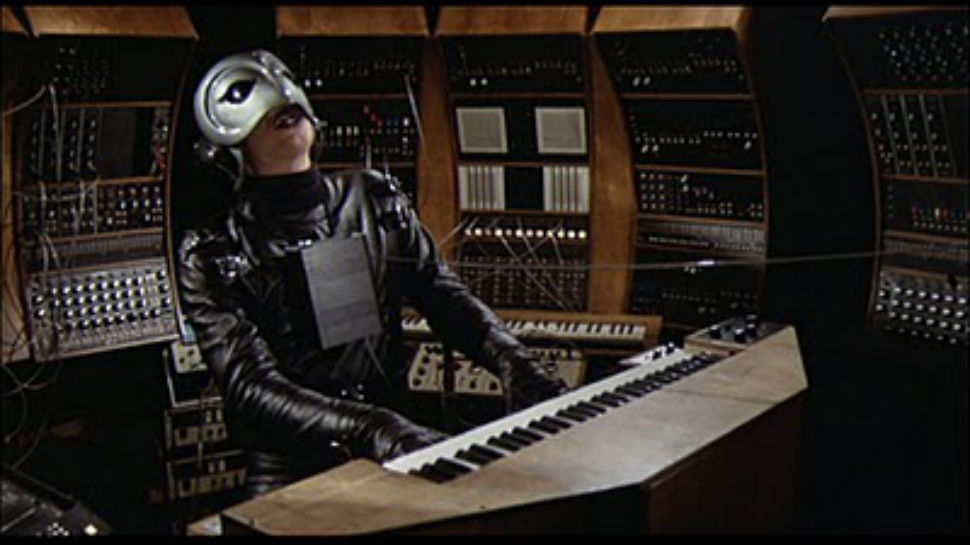
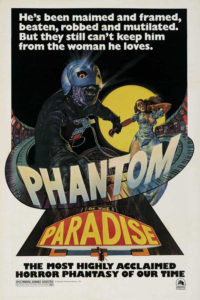
Returning a blu-ray copy of Brian De Palma’s Phantom of the Paradise to my local library inspired the clerk to engage me in a ten minute conversation about how he not only enjoyed the film, but was surprised that he enjoyed it as much as he did. The clerk went on to say that Paul Williams’ songs were instantly catchy and how he remembered Williams being a mainstay of 1970’s television on shows like The Love Boat.
I wholeheartedly agree with that library clerk and I’m sorry that I put off watching Phantom for as long as I did. Even being a fan of De Palma’s films, it was easy to shove Phantom off to the side. On the surface it seems so very unlike the rest of his work. When you think DePalma, you think sensuality, violence, and Hitchcock; you don’t think glam musical.
But you should! Phantom of the Paradise is a De Palma film through and through, but with a mean satirical twist. It’s got horror, split screen, and voyeurism. Who else could have made this film? Nobody.
Phantom of the Paradise centers on Winslow Leach (William Finley), a young composer working on an epic musical about Faust. His work is stolen from him by Death Records mogul Swan (Paul Williams). During an attempt to regain his life’s work, Winslow is caught in a record press and becomes disfigured, driving him to insanity.
Swan has hired Phoenix (Jessica Harper) to sing in his production of Faust and begins to romance her, much to Winslow’s dismay. From here things go the direction of The Phantom of the Opera, only with more singing and blood.
You may be familiar with Jessica Harper from her starring role in Argento’s Suspiria. Phantom was her first major film role and she shines as bright as ever, and proving to have a decent singing voice to boot.
Paul Williams’ songs are indeed instantly catchy, which should be no surprise coming from someone who wrote for Three Dog Night, The Carpenters, and David Bowie. He’s also very creepy as Swan, completely selling the decadent rock god lifestyle.
Finley vacillates from goofy to tragic to frightening as Winslow/The Phantom and I find myself wanting to track down a version of his iconic mask for Halloween. Or just to have. To wear every now and then. Around the house. As one does.
If you’re willing to take a walk on the wilder side, Phantom of the Paradise makes for a great middle selection in a triple feature with The Rocky Horror Picture Show and Repo! The Genetic Opera.
The Untouchables
(1987, Paramount Pictures, Brian De Palma)
by David Strugar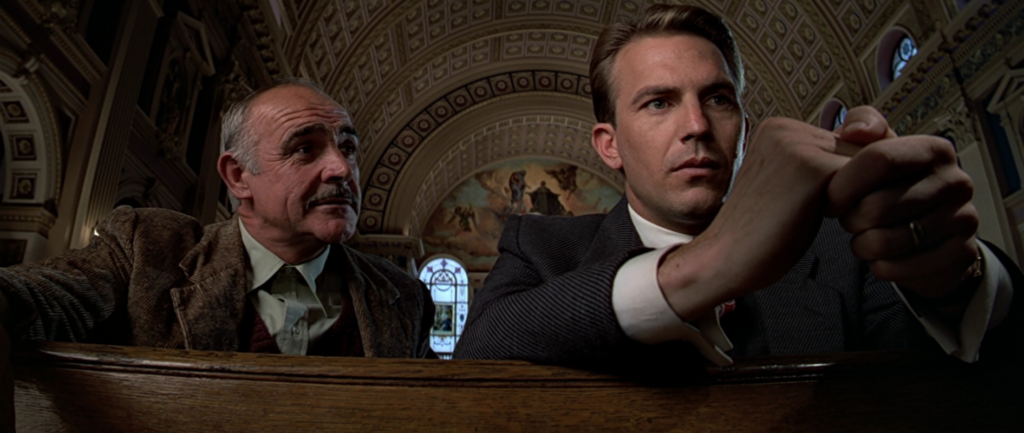
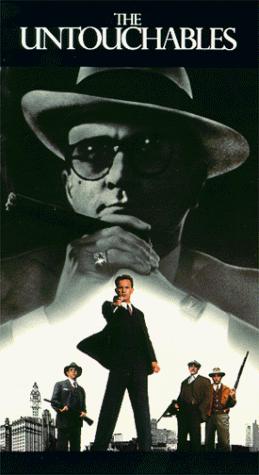 I’d seen the famous staircase shootout scene from The Untouchables countless times all the way through film school—often played alongside the Battleship Potemkin sequence to which it pays homage. Coming as it does after a very dispiriting series of events for the titular group of characters, the sequence proved quite nail-biting. It’s definitely the type of scene where you want to stand up from your chair and yell at the characters to just get moving, already (I mean, really, how much more effort would it have taken Kevin Costner to make it up that one last step so that the baby carriage didn’t go flying?).
I’d seen the famous staircase shootout scene from The Untouchables countless times all the way through film school—often played alongside the Battleship Potemkin sequence to which it pays homage. Coming as it does after a very dispiriting series of events for the titular group of characters, the sequence proved quite nail-biting. It’s definitely the type of scene where you want to stand up from your chair and yell at the characters to just get moving, already (I mean, really, how much more effort would it have taken Kevin Costner to make it up that one last step so that the baby carriage didn’t go flying?).
As for the rest of the movie, director Brian De Palma paints with a nice stylistic touch that adds just the right hint of noir to the film while still authentically representing Prohibition-era Chicago. He even pulls off a POV handheld scene that doesn’t feel out of place at all and works to great dramatic effect. However, in the middle of the film, an ambush on the Canadian-US border becomes a brightly-lit Western, with guns, alcohol, and charging horses. So that’s a little strange.
Also, the score during the raid scenes and the ambush is overbearingly heroic, killing the slow build of the suspense in an unnecessary effort to add more momentum to the action, and possibly trying to assuage any concerns we’re having about the violence employed by our protagonists.
Likewise, the script by David Mamet alternates between his trademark elevated dialogue—like the first meeting between Costner and Sean Connery’s characters—and ham-fisted clichés, like the scene where a grieving mother comes to Costner’s office to beg him to make the bad guys pay for the death of her daughter. Robert DeNiro beats the scenery with a baseball bat, but there’s really no way you can overplay a character as big as Al Capone. However, since Capone’s fate is a little less than satisfying in real life, a fictionalized version of one of his henchman shows up for Costner’s Ness to have a good-old fashioned climactic brawl with.
For me, many elements of the film have aged, not badly, but oddly. It’s a mystery to me now how Kevin Costner got famous, but his attractive dullness works here to portray the morally upright Elliot Ness. The whole storyline of a police force fighting its own corruption is suddenly timely again, as well as the ethical questions of fighting violence with violence—or of fighting a crime that doesn’t necessarily have to be a crime.
Overall, while certain scenes and performances were effective, the film felt scattershot, raising moral questions it didn’t really want to dig into for the sake of some pot-boiling suspense and shoot-‘em-ups.
Passion
(2012, SBS Productions, dir. Brian De Palma)
by Erik Yates
 Passion is an example of Brian De Palma’s later years output that includes Redacted, and the Black Dahlia. He has largely been a streaky director with much early success in films like Blow Out, Dressed to Kill, The Fury, or Scarface, with occasional upticks like The Untouchables and Mission: Impossible. Otherwise, Brian De Palma, as a director, is very much a mixed bag. With Passion, he combines his signature go-to of erotic thriller with a takedown of corporate greed, in a remake of the French film Crime d’amour (Love Crime).
Passion is an example of Brian De Palma’s later years output that includes Redacted, and the Black Dahlia. He has largely been a streaky director with much early success in films like Blow Out, Dressed to Kill, The Fury, or Scarface, with occasional upticks like The Untouchables and Mission: Impossible. Otherwise, Brian De Palma, as a director, is very much a mixed bag. With Passion, he combines his signature go-to of erotic thriller with a takedown of corporate greed, in a remake of the French film Crime d’amour (Love Crime).
Rachel McAdams plays Christine Stanford, a tough corporate boss who is morally compromised in that she is willing to take credit for work her protégé, Isabel James (Noomi Repace), has produced. She claims the moral high ground in claiming that it’s “just business” and because she does this to Isabel’s face, and not behind her back. But Christine tries to muddy the waters by making a pass at Isabel. The whole of the film comes down to a statement Christine makes to Isabel about how she used to desire respect, but now she wants to be loved. The rest of the film plays out as a power struggle between those two ideals and how the corporate world is an incubator for the sort of power struggle that ensues between those two extremes….even if it leads to murder. Much of this film is slow, dull, and uninspired (especially with the 1980’s Kenny G inspired soundtrack). It is only in the last 20 minutes that flashes of classic De Palma come through. By then, we’ve lost any passion for this story, as good as the cast may be.
Get to Know Your Rabbit
(1972, Warner Brothers, dir. Brian De Palma)
by Jim Tudor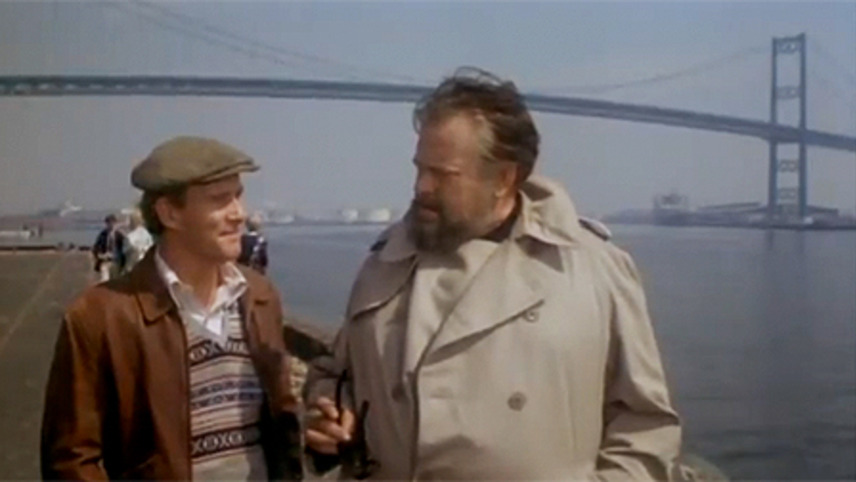
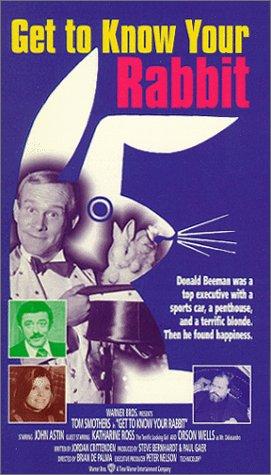 “Admitting” to having seen a film so obscure that it’s been on my own active to-see list since 1995 is, I know, not much of a reveal. But being the longtime fan of Brian De Palma that I am (hence, it’s “to-see” status), and having seen most everything else, the opportunity to fast-track this movie to the front of my ever present and ever shifting film critic’s mandatory viewing queue was one that could not be passed up. Thanks to Warner Archive, the film finally became available on DVD a few years ago. Thanks to kind relatives, I finally own it. Thanks to this exercise, I finally got to watch it.
“Admitting” to having seen a film so obscure that it’s been on my own active to-see list since 1995 is, I know, not much of a reveal. But being the longtime fan of Brian De Palma that I am (hence, it’s “to-see” status), and having seen most everything else, the opportunity to fast-track this movie to the front of my ever present and ever shifting film critic’s mandatory viewing queue was one that could not be passed up. Thanks to Warner Archive, the film finally became available on DVD a few years ago. Thanks to kind relatives, I finally own it. Thanks to this exercise, I finally got to watch it.
And? It’s just fine. Released in 1972, Get to Know Your Rabbit is a smile-inducing bit of anti-establishment fluff. Very much of its era in a low budget kinda way, this Tom Smothers vehicle (of the then-still recently canned Smothers Brothers Comedy Hour) has as many worthwhile moments as it does pure corniness. Comedy has never been De Palma’s strong point (think blustery blowhards in tacky suits, coming and going), which by default makes this his one of his top films of that genre. (Eeking out Wise Guys; perhaps short of Hi, Mom!). In a movie full of pleasurable supporting performances and cameos (M. Emmett Walsh, Bob “Super Dave Osbourne” Einstein, John Astin), Orson Welles is a standout as a washed-up magician sensei-type. The casting is perfect in more ways than one, as Welles’ character urges men to abandon the corporate sector for a career as a tap dancing magician. (“To be a great magician, you must get to know your rabbit!”). This is the ill advised path taken by Smothers, who soon finds himself on the bus to perform his hokey act in dumpy clubs in Elgin, Illinois and Nowheresville, Nebraska. His wild on-stage outfits alone make it worth following him on these strange jaunts.
The most aged aspect of Rabbit is the film’s hanky-panky attitude towards women. As far as such oft-breast-baring sex objects go, the ladies in this film are all very funny. (Jerky Man: “How long have you been a cheap broad?” “…It comes and goes”). But even Katherine Ross, an attractive and popular star of the time with a number of good scenes as a spirited magic devotee, is refused a name by the screenplay. She is officially called “The Terrific-Looking Girl”.
As fun as Rabbit can be, there’s an inescapably low-rent quality about it. Although it’s technically De Palma’s first studio film, it’s clear he wasn’t given much in the way of power or resources. It’s full of what would become his signature visual flare, even if most of his flourishes here lack real substance to back them up. (That would come later, as he’d find his true voice with Hitchcock-ian thrillers and horror). That said, it’s easy to wonder what Warner Brothers was looking for in green lighting this odd, cultural curio. It’s a fun romp that requires some heavy suspension of today’s improved gender values, but also not surprising that it wasn’t magic for the attempted film career of Tommy Smothers.


